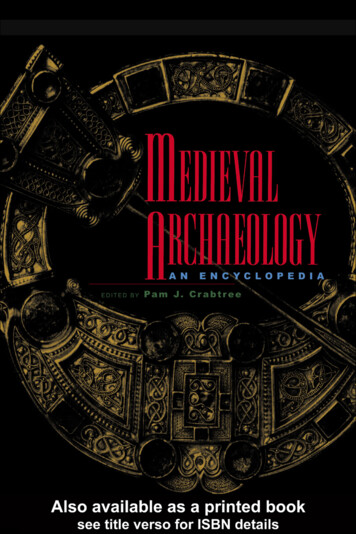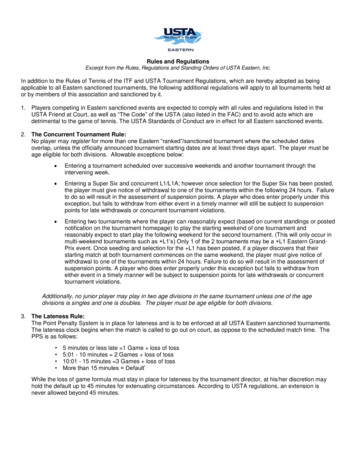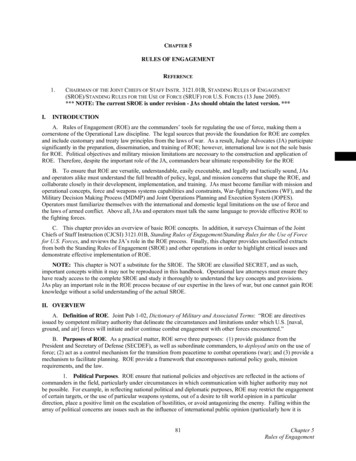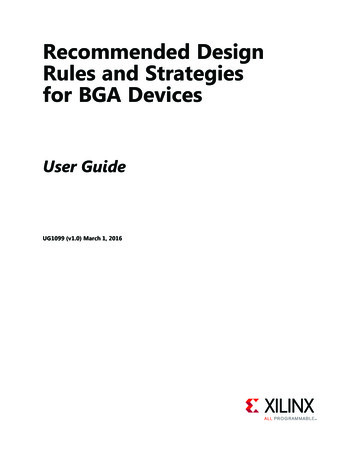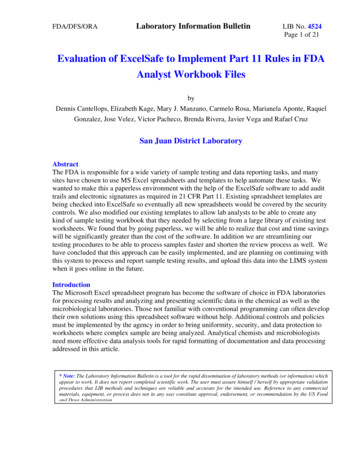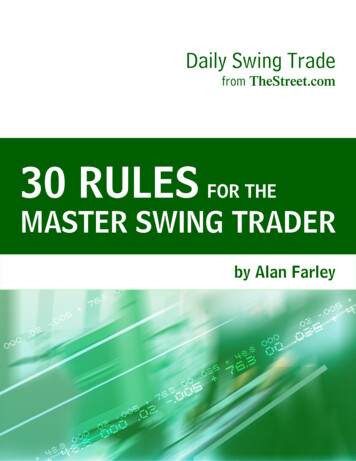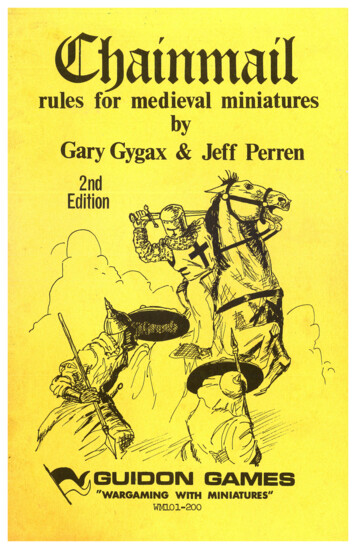
Transcription
rules for medieval miniaturesbyGary Gygax & Jeff Perren2ndEdition
!CbainmaiIrules for medieval miniatures2ndEditionbyGaryGygax&Jeff PerrenILLUSTRATEDBY DONLOWRY
With thanks toall the Fantasy and Medieval enthusiastswho offered so many helpful suggestitDns--especiallyLen Lakofka, Ken Bourne, Stu Trembly and Ernie theBarbarian.1st Edition., Copyright 1971, Donald S. Lowry2nd Edition, Copyright 1972, Donald S. LowryPRINTED IN U.S.A.
TABLE OF CONTENTSPageWARGAMING WITH MINIATURES1RULES FOR MEDIEVAL MINIATURESTurn Sequence . ,.Terrain Effects Upon Movement ".Terrain Selection . ".Movement.Formation and Facing . . .Fatigue . . . . .Missile Fire (excluding Gunpowder and Catapults) .Catapult Fire . . .Gunpowder Weapons .Melees . . .Melee Optionals . ".Morale . -.Historical Characteristics Optional) . . .Weather . -.Sieges . . . . , . . . . . . . . . . . . . . . . . . . . . . . . . . .Man-to-man Combat . ".Jousting . . ".Suggested Point Values . ".45667788910121415161919 222324FANTASY SUPPLEMENTFantastic Characteristics . "".Hobbits, Sprites, Dwarves, Goblins, Elves .Orcs, Heroes (and Anti-heroes), Super Heroes .Wizards . . . .-. ".Wraiths, Lycanthropes, Trolls.Balrogs, Giants, Ents, Dragons.Roes, Elementals . .Wights . . . -.Magical Weapons .Air Movement . . . . . . -. . .Catapult Fire vs Fantastic Figures .Combination Figures . . . . .Fantastic Sieges . -. . . . ; . . . . . . . . . . . . . . . .General Line-up . . . . .252626272830313233343434353535TABLESCombat Tables . . . .Man-to-man Melee Table . .Individual Fires with Missiles . .Jousting Matrix . .Fantasy Reference Table . .Fantasy Combat Table . .APPENDIX AAPPENDIX BAPPENDIX BAPPENDIXCAPPENDIX DAPPENDIX E
IntroductionGames based on warfare have interested men for centuries, as such games ascheckers and chess prove. The latter games are nothing less than the warfare ofthe period in which they were developed, abstracted and stylized for play on aboard. Chess is so abstracted that it is barely recognizable as a wargaine. At theother end of the spectrum, and of much more modern invention, are military miniatures. - By use of figures scaled down to an .inch or two in size the players morerealistically simulate warfare and are not tied to a stylized board. Miniature warfare allows the combatants to have a never ending variety of battles over varyingterrain, even refighting historic actions involving tremendous armies!In order to playa wargame it is necessary to have rules, miniature figures andaccompanying equipment, a playing area, and terrain to place upon it. There canbe no doubt that you have fulfilled the first requirement, for you have purchasedthis set of rules. Your troops can be any scale that you desire. The playing areathat the battles are fought out upon should be a table rather than the floor . It canbe from a minimum of 4' to a maximum of 7' wide, and it should be at least 8' inlength. These sizes will assure ample room for maneuver. There are severalmethods of depicting the terrain features generally used for wargames, such ashills, wOdds, rivers, roads, etc.First, youcan utilize odds and ends to simulate terrain, or buy commercialmaterials from your hobby suppl ier, and lay them out on a flat surface to form thebattleground. Scraps of wood with the edges and corners smoothed are pyramidedto form hills of varying size and elevation. Twigs with pieces of green sponge oflichen stuck on and set in clay bases serve as miniature trees. Rivers are drawnwith blue chalk or made with strips of blue plastic odelL Roads are representedin much the same way as rivers,only brown is used . With a little imaginationalmost any kind of terrain can be constructed in like manner.A more advanced. method is to construct terrain on 2'x2' pieces of masonite orsimilar material, sculpting hills, gullies, ridges, rivers, and so on with plasterand/or papier mache. Trees and houses are set into the soft modeling compound,and permanent sections of wargaming terrain are thus made. When a game is to beplayed,theterrain blocks are simply laidouttoform the kind of battlefield desired.Finally, the most complicated form of wargaming table is the sand table. Asand table is really nothing more than a flat table with a raised edge to allow thetop to be covered with a few inches of sand. Of course, all that sand will weighvery much when wetted down to form terrain features, so the table must be of verysturdy construction and rest on a basement or garage floor. The sand table'sgreatest advantage is that it allows full rein to the players' desires for differinglandscape, and it provides the most realistic looking battlefields for miniaturewarfare.1
The forces to be pitted against each other can be drawn from an historicalaccount, chosen by point value, assigned by a third (neutral) party, or worked outfrom a "campaign" situation where larger armies are moved on a map until hostileforces come into contact. The balance between the forces is something best determined by experience. However, troops armed with missi Ie weapons are generallymuch more powerful than like troops that lack such weapons. Armored men areusually better than troops without protection--although they move more slowly.Trained pikemen are more than a match for any but an army that has either equallyarmed fighters or numerous miss i Ie troops. A tabl e of point val ues appears in theserules, and you will find it helpful in selecting balanced forces. Playing abilityand terrain must also be taken into consideration, however. If, for example, thebetter player is to receive a 300 point army, it might be wise to allow his opponent to select 50 additional points worth of troops in order to balance the game.Similarly, if one player decides the kind of terrain the battleground is to be composed of - -or the historic terrain favors one side--the side with such a terrainadvantage should probably have a conSiderably weaker army.As the men are scaled down in size, 50 is the field of combat. Therefore, amove of a few inches on the table top will represent a march of ten times as manyyards for our small campaigners. They move and they fight in miniature. Theplayers order their formations about, just as medieval mil itary commanders did(and much more efficiently inalll likelihood, fora number of rather obvious reasons),but the proof of the opponents' ability only comes incombat situations. Here, eachfigure will do only as well as its known capabilities foretell, with allowances forchance factors which affect every battle (such as dice throwing in miniature warfare) .The different kinds of troops fight in relation to each other kind. Given normalprobabi I ities, a body of horsemen wi II always defeat a like number offootmen (excluding pike armed troops), but a small chance that the footmen will somehowtriumph remains, and that chance is reflected in the combat tables employed. Notethat should the infantry manage to surprise the horsemen by attacking from the rearor flank, they have a much improved chance of winning the combat, or melee.Thus, while movement is scaled to size (and a set time period during which scalemovement takes place), combat is based On the histol'ically known capabilities ofeach particular kind of fighting man and then expressed as a dice rolling probability in relation to like and differing types of soldiers. A close simulation of actualcombat is thereby attained. While a pawn can always take a knight in a chessgame, a similar situation will seldom occur in miniature warfare. But the knight(cavalry) just might fail to take the pawn (infantry) when the battle isfought inminiature! In addition,the mental and physical condition of the men (their morale)is taken into consideration in this game.-Morale is checked before and after combat, basing the determination on historical precedent, just as the fighting ability in actual cases was.drawn upon to calculate melee results. A loss of "heart" is at least as serious as a defeat in combat, and perhaps more 50, for most battles are won without the necessity of decimation of the losing side.Finally, how is it determined when the battle is over and one side awarded thelaurels of victory? As with all facets of miniature wargaming, it is up to the parties concerned, the game can continue until One side is reduced below a certainpercentage of its original strength--25'/0, 50'/0, 75,/0, or whatever. The battle2
can be continued unti lone opponent has driven his enemy completely off the battlefield. Or the players can assign set values to certain terrain features and trooptypes, keeping count of gains .and losses for a set number of turns, the winnerbeing the side with the greatest number of accumulated points. If both opponentshave an historic bent, they can refight an actual battle (or evenan entire campaignin a series of battles), and adjudicate the end result based on what actually tookplace in the past.With no other form of wargaming··-or nearly any form of game for that matter--isthe player given the scope of choice and range for imag ination that miniature warfareprovides. You havecarte blancheto create or recreate fictional or historic battlesand the following rules will, as closely as possible, simulate what would havehappened if the battle had just been fought in reality.3
I'f""", . tv ii "!i-' "-;;":: . -([bainmail::J-- .rules for medieval miniaturesThe MiddleAges is probably oneof the best known but least understood periodsof history. We do not pretend that these wargame rules will add significantly toanyone's knowledge, albeit they do reflect medieval warfare reasonably well, butthey have a secondary purpose: Besides providing you with an exciting and enjoyable battle game, we hope that these rules will interest. the wargamer sufficientlyto start him on the pursuit of the history of the Middle Ages. Such study will atleast enrich the lifeofthe new historian, and perhaps it will even contribute to thestudy of history itsel f.The LGTSA Medieval Miniatures Rules were developed primarily for use withElastolin and Starlux figures, which are 40mm scale. However, they may beused equally well with any scale--inc luding the inexpens ive Airfix "Robin Hood"and "Sheriff of Nottingham" 25mm plastic figures. Although the rules have beenthoroughly play-tested over a period of many months, it is likely that you willeventually find some part that seems ambiguous, unanswered, or unsatisfactory.When suchasituation arises settle it among yourselves, record the decision in therules book, and abide by it from then on. These rules may be treated as guideI ines around which you form a game that suits you. It is always a good idea toamend the rules to allow for historical precedence or common sense--follow thespirit of the rules rather than the letter.The ratio of figures to men assumed is 1:20, the ground scale is 1 ":10 .yards,and One turn of play is roughly equivalent to one minute of time in battle. Thetroop ratio will hold true for30mm figures, but if a smaller scale is used it shouldbe reduced to 1:10.4
TURN SEQUENCETHE MOVE/COUNTER MOVE SYSTEM1.Both opponents roll a die; the side with the higher score has the choice ofelecting to move first (Move) or last (Counter-move).1.The side that has first move moves its figures and makes any split-movesand missile fire,. taking any pass-through fire possible at the same time.3.The s ide that has last move now moves its figures and makes any spl itmoves and missile fire, taking any pass-through fire possible at the sametime.4.Artillery fire is taken.5.Missile fire is taken.6.Melees are resolved.7.Steps 1 through 6 are repeated throughout the remainder of the game.Note: Missile fire from split-movinOg troops is considered to take effect immediatelyduring the movement portion of the turn, and the same is true of pass-throughfire. All other fire, both artillery and missile, is considered to simultaneously take effect just prior to mel ee resolution.THE SIMULTANEOUS MOVEMENT SYSTEM1.Both s ides write orders for each of their units (g roups of figures of like type) ,including direction of movement and facing.2.Both sides move their units according to their written orders, making one-halfof the move, checking forunordered melee contact due to opponent movement,and conducting split-moves and missile fire and taking any pass-throughfire; then the balance of movement is completed as ordered.3.Artillery fire is taken.4.Missile fire is taken.5.Melees are resolved.Note: Exact orders for each unit (group of figures of like type) must be given.Cavalry may be given the order to "Charge if Charged" (CIC) I either in theirown behalf or in support of any nearby friendly unit. Such CIC movementbegins at the one-half move and is only half of a normal charge, i.e., a unitof medium
tures. -By use of figures scaled down to an .inch or two in size the players more realistically simulate warfare and are not tied to a stylized board. Miniature war fare allows the combatants to have a never ending variety of battles over varying terrain, even
